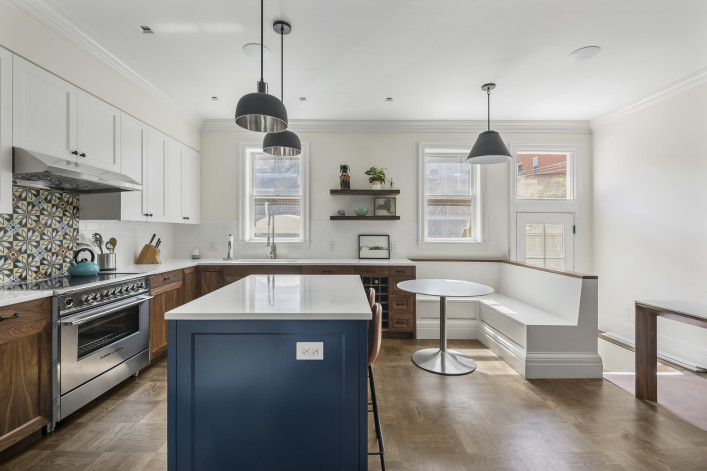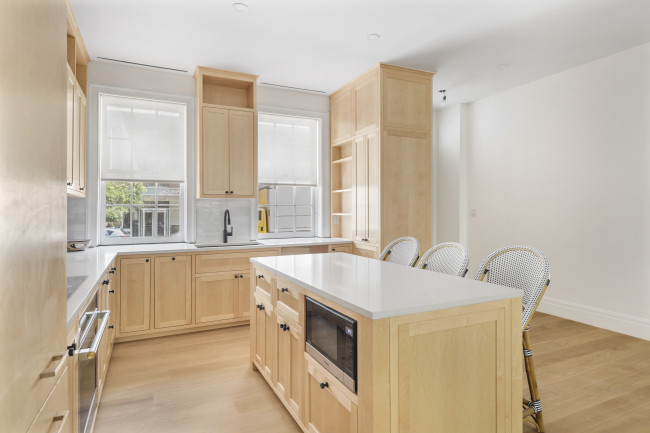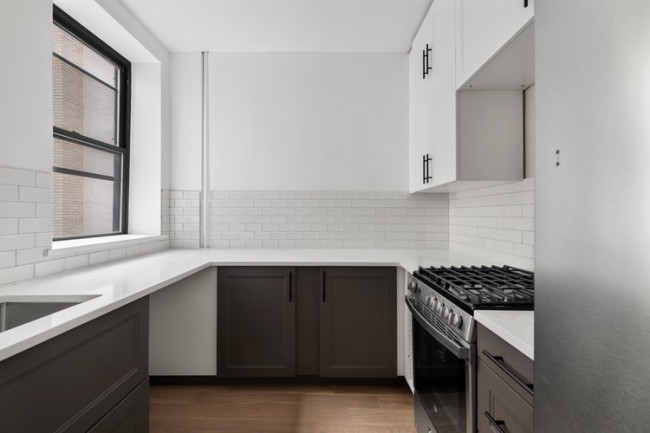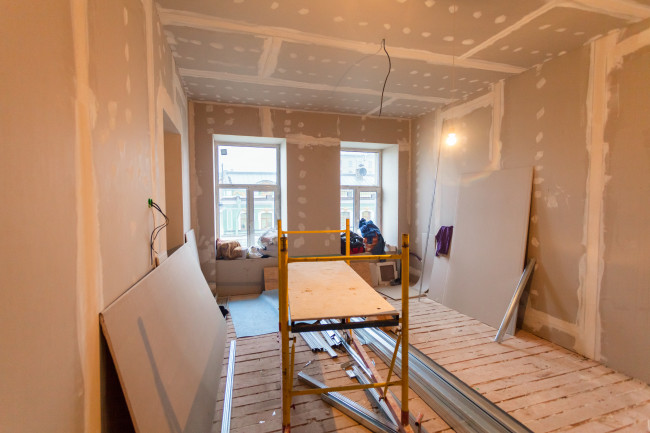When doing a gut renovation, choosing the right layout is critical. Bolster gives owners fixed-price options

The homeowners of this Astoria property increased the footprint of their home via the roof, kitchen, and dining area.
One of the first and most important steps of a major gut renovation is determining your new layout, a decision which can have a major impact on a project’s overall size and cost and occurs during the Design Phase of the project. For major gut renovations in New York City, this phase typically lasts three to six months, depending on the scope of the project.
The main components of the Design Phase include:
Schematic Design: When the new layout of the home is determined
Design Documentation: When the board and the Department of Buildings have given their comments
Construction Documentation: When the homeowner finalizes their selections
During Schematic Design, homeowners will first work in-depth with their renovation team to determine the new layout of their project. Bolster, a data-driven design-build firm in NYC, offers a unique pricing process that follows the three distinct phases of Design.
“One of the benefits of Bolster’s unique pricing process is that homeowners have visibility into the total cost of their project at every stage,” says Jeronimo Aguilar-Gutierrez, executive vice president of Bolster.
Understanding renovation costs upfront and ultimately providing a fixed-price renovation is part of Bolster’s ethos. Bolster guides its homeowners through an iterative design and pricing process: as they gain more design information, they can provide better construction pricing accuracy, culminating in a 100 percent fixed-price cost for a renovation project. The result is a zero-risk construction process, backed by the Bolster Promise, which absorbs any unforeseen costs.
As part of Schematic Design, “It’s usually an architect’s responsibility to help homeowners understand their options within reason,” says Bolster architect partner Michael Fasulo. Architects will present one option as a proposal for their layout based on past conversations with homeowners, but they will also include a few other options for the homeowner to review.
Below are a few common scenarios in which alternate layouts are presented.
Spend less, build faster with Bolster. "We deliver risk-free, on-time, on-budget renovations," says Bolster's CEO and co-founder Anna Karp. "We give you a fixed-priced cost up front, and absorb all unforeseen project costs after the demolition phase. Bolster--not you--is responsible for any and all surprises." Ready to start your renovation? Learn more >>
Protecting against probing results
Alternate layouts can be presented as an option in case probing (the process during which a building’s underlying conditions are evaluated) returns unfavorable results. Probing often takes place during later phases of design, such as Design Development, so it’s important to have a backup plan.
This was the case with Bolster’s Brooklyn Heights homeowners. Their prewar apartment had never undergone a renovation, so they didn’t know what to expect behind the walls. As Bolster CEO and co-founder Anna Karp likes to say, “You can’t x-ray a property.”
“A few options were presented to the homeowners because we weren’t sure if we were going to be able to remove a wall in the kitchen or not,” Michael says. “We hadn’t probed yet, so we didn’t know where exactly the pipes were. The alternate layouts were a reaction to the possibilities and unknown factors.”
The homeowners were given two plausible layout options for their renovation: a gracious kitchen (their preference), and a smaller kitchen that would be functional but more limited in space. The smaller kitchen was a backup plan in case pipes were discovered and the kitchen couldn’t be expanded.

How layout choices impact cost
Different layout options can also be presented to show a homeowner how changing the scope of their project impacts their renovation costs. This is because the main factors that impact scope and thus cost in a renovation are mechanical, electrical, mechanical, and plumbing work—and creating layout changes, by touching the building envelope, (i.e. walls, layout changes) affects all three. In seeing this, it’s easy to understand how the layout of a home— which includes additional walls, structure, and ceilings—can impact the cost because of all the seemingly small factors that add up in the end.
This was the case for Bolster’s Astoria homeowners, who weren’t sure where they wanted to prioritize their budget. Bolster gave them options that showed them the possibilities: The first plan was relatively modest and offered designs that didn’t break through their back wall or go through their roof, which kept costs down. The second plan involved extending the back of the home to provide an eat-in kitchen and breaking through the roof to install an electric skylight that would provide roof access for the homeowners.
“If you want to keep your budget down, you can’t tear up the whole building envelope,” Michael says. “If the building’s shell works as is, you can choose to do more cosmetic interior work, which is a scale of cost that’s much lower than reframing the home and knocking holes in the roof.”
Understanding different layout options can help homeowners determine where to spend, where to save, and thus where they may be able to invest more. Significantly altering the building envelope has a cascading effect on renovation costs, and homeowners may have less room in their budget to prioritize custom or high-end design selections. In this case, the Astoria homeowners had to decide what was most important to them.

Seeing a home with fresh perspective
Finally, it’s common to present alternate layouts that the homeowner may not have considered as a possibility. This was the case for Bolster’s Tribeca townhouse homeowners Elizabeth and Daniel: The top floor of their home had awkward dormer windows, misshapen rooms, and a bathroom that lacked a bathtub (not ideal for a family with two toddlers). Elizabeth and Daniel initially wanted the third floor as their primary bedroom suite, but were pleasantly surprised when their Bolster architect, Matthew Rauch, presented alternate options to them during Schematic Design.
“Our architect was integral in helping us realize our vision to match the needs of our growing family,” says Elizabeth. “With his support, we designed a haven for our children on the top floor, creating a playroom we never knew could even be an option, and thus increasing the room count of the house. Matt showed us possibilities and options for every decision, putting us at ease every step of the way.”

What these homeowners chose
Given their layout options, what did these homeowners ultimately decide for their renovations?
Brooklyn Heights homeowners: The probe thankfully revealed no conflicting pipes behind the walls, and the homeowners were able to secure their large, gracious kitchen that they wanted as part of their new layout. With this out of the way, Michael has moved on to negotiating the location and layout of their primary bathroom with the building, which has strict rules about wet over dry, as many NYC buildings do. (Pro tip: This is something that your architect can go to bat for to try to get the most favorable outcome for your renovation.)
Astoria homeowners: In the end, the homeowners decided that converting to all-electrical and increasing the footprint of their home via the roof, kitchen, and dining area was the top priority for them, and thus they confidently increased their scope, putting them at the high end of their renovation budget ($1.5 million). The homeowners prioritized energy efficiency and sustainable upgrades, with an added focus on flood prevention following the impact of Hurricane Ida in Sept 2020. The homeowners appreciated Bolster’s transparency around the impact on total costs for this endeavor. No surprise, their biggest cost increases from their first pricing workshop to their final costs were roofing ($4,125 to $39,000) and electrical ($66,500 to $120,000).
Tribeca homeowners: These homeowners ultimately decided to go with their architect’s suggestion of making the third floor of the home for their children. This increased the number of rooms in the home and allowed them to install a bathtub—necessary with young children - both of which they’re very excited for.
Tips for choosing a layout
For homeowners in the Schematic Design phase of their project working to determine a layout, here are some top tips from Bolster experts and homeowners:
Stay engaged and focused on the process: Think about your daily habits currently, and envision how you want to live in your new layout. How you spend your time at home–cooking, working, exercising, hosting—will help nail down your layout (i.e. removing walls for an open kitchen; the addition of walls to create a home office; digging out a cellar to create a home gym).
Consider your priorities: Is budget your top priority? Resale value? Planning for a growing family? Aging-in-place? By exploring alternate layouts, you can figure out how best to prioritize your budget on what means the most to you.
Make decisions early: This will make your costs more predictable and be less stressful and allow a clear direction moving forward through all of the phases. “You don’t want to change your mind during Construction Documentation,” Michael says. Not to mention with supply chains still being impacted, your renovation team can work to procure your items as soon as possible to protect you against potential delays.
The Bolster Smart Renovation Zero-Risk Guarantee
How can a design-build firm guarantee a Zero-Risk renovation?
Bolster has pioneered Smart Renovation. We apply quantitative analysis along with our proprietary technology solution to identify and quantify the performance risk on every renovation project. The result is a personalized strategic approach to each renovation that allows us to absorb 100 percent of the homeowner’s risk. Your home will be beautifully designed, and delivered on-time and on-budget. That is our guarantee.
Smart Renovation & Zero-Risk means that Homeowners are now free to dream.
To start your major home renovation project visit bolster.us.
The Bolster Promise video
You Might Also Like


























